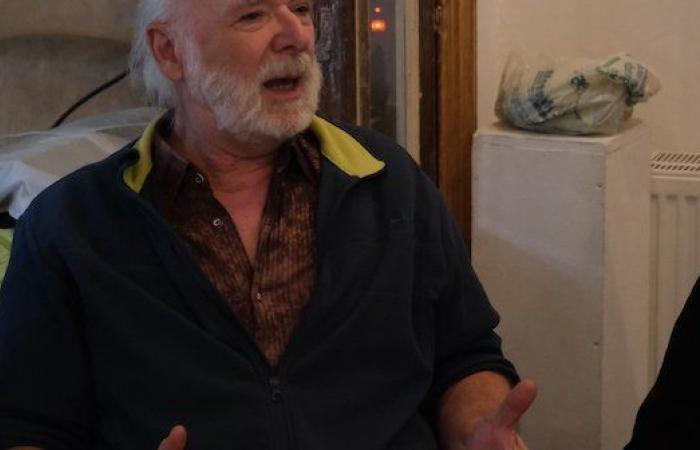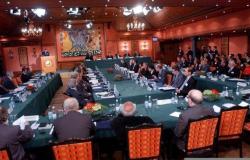The CADTM International Council, which meets once a year, allows us to take stock of the global political situation and evaluate the progress of the network’s work.
The previous meeting of the CADTM International Council took place a year earlier in Marrakech on the eve of the counter-summit facing the World Bank
World Bank
BM
The World Bank brings together two organizations, the IBRD (International Bank for Reconstruction and Development) and the IDA (International Development Association). The International Bank for Reconstruction and Development (IBRD) was created in July 1944 in Bretton Woods (United States), at the initiative of 45 countries gathered for the first Monetary and Financial Conference of the United Nations.
In 2022, 189 countries are members.
Click for more details. and at FMI
FMI
International Monetary Fund
The IMF was created in 1944 at Bretton Woods (with the World Bank, its sister institution). Its goal was to stabilize the international financial system by regulating the movement of capital.
To date, 190 countries are members (the same as the World Bank).
Click for more details. . We would first like to thank the volunteer interpreters who allowed us to hold this meeting. We also thank Aquilone, which welcomed us for these three days. Thanks also to Casa Nicaragua and Cafeteria Collective Kali for their hospitality during the Fall Meetings and international advice.
The first day was dedicated to a presentation and discussions around the multicrises facing capitalism, as well as an examination of emerging social and political resistance across the world. Here is an overview of the main crises addressed:
• Ecological crisis: The effects of climate change are hitting populations in the South increasingly hard, accentuating vulnerabilities and injustices.
• Food crisis: The alarming increase in the number of people suffering from hunger reflects an increasingly critical situation.
• Global economic crisis: A fall in the overall growth rate, particularly marked in the Northern countries. The flagging global economy remains mainly driven by countries like India and China.
• Financial crisis: Since the 2007-2008 crisis, the financial sector has neither been reformed nor cleaned up. We are witnessing a hypertrophy of finance, leaving the global economy weakened, with growth based on speculative bubbles, while production lags behind.
• Commercial crisis: After strong expansion in the 1990s and 2000s, world trade is growing very slowly. Trade tensions between the United States and the EU on the one hand and China on the other hand have intensified, and protectionist policies are making a comeback because the EU and the United States are not capable of facing competition from China which has acquired superiority particularly in the field of solar panels and electric vehicles.
• Crisis of multilateral institutions: L’OMC
OMC
World Trade Organization
Created on 1is January 1995 to replace GATT. Its role is to ensure that none of its members engage in any protectionism, in order to accelerate the global liberalization of trade and promote the strategies of multinationals. It has an international tribunal (the Dispute Settlement Body) judging possible violations of its founding text of Marrakech.
The WTO operates according to the “one country – one vote” mode but the delegates from the countries of the South are no match for the tons of documents to study, the army of officials, lawyers, etc. northern countries. Decisions are made between powerful people in the “green rooms”.
Site: www.wto.org is paralyzed by the lack of appointment of judges under the Trump administration, and the UN, ignored on environmental and geopolitical issues, is seeing its influence decline.
• Geopolitical crisis: Major conflicts continue, notably in Palestine and Lebanon, Ukraine, the DRC, Sudan and Yemen.
• Social crisis: Inequalities, which had been reduced in certain regions of the world, are exploding again. While the richest accumulate unprecedented fortunes, the most precarious layers sink into poverty. This precariousness is accompanied by a continuous erosion of workers’ rights.
• Dispossession by this
This
Multilateral debt : Debt owed to the World Bank, the IMF, regional development banks like the African Development Bank, and other multilateral institutions like the European Development Fund.
Private debt : Loans taken out by private borrowers regardless of the lender.
Public debt : All loans contracted by public borrowers.
: The increase in consumer credit, aimed at maintaining the consumerist model, traps more and more people in debt and leads to foreclosures or evictions of housing or unpaid debts.
• Debt crisis: The debt of the countries of the South and the North has reached new heights. With the increase in interest rate
Interest rate
When A lend money to B, B repays the amount loaned by A (the capital), but also an additional sum called interest, so that A has an interest in carrying out this financial transaction. The higher or lower interest rate is used to determine the amount of interest.
Let’s take a very simple example. If A borrows $100 million over 10 years at a fixed interest rate of 5%, it will repay in the first year one tenth of the capital initially borrowed ($10 million) and 5% of the capital owed, i.e. $5 million, so in total 15 million dollars. The second year, he repays another tenth of the initial capital, but the 5% only concerns $90 million remaining due, or $4.5 million, so in total $14.5 million. And so on until the tenth year when he repays the last 10 million dollars, and 5% of this remaining 10 million dollars, or 0.5 million dollars, so in all 10.5 million dollars. Over 10 years, the total repayment will be $127.5 million. In general, the repayment of capital is not made in equal installments. In the first years, repayment mainly concerns interest, and the portion of capital repaid increases over the years. Thus, in the event of a cessation of repayments, the remaining capital due is higher…
The nominal interest rate is the rate at which the loan is taken out. The real interest rate is the nominal rate minus the inflation rate.
these countries find themselves in a vicious repayment spiral, favoring a new wave of austerity policies and the great return of the IMF. China is also very present in the Global South and allocates emergency credits to avoid being faced with payment suspensions.
• Democratic crisis and rise of the far right: Faced with growing protests from populations experiencing a tightening of their living conditions, governments are increasingly using authoritarian measures to impose their authority. At the same time, part of the world’s populations are increasingly seduced by far-right xenophobic discourse targeting migrants and the most vulnerable.
- Thanks to the interpreters for their volunteer work during the three days of the International Council
In addition to these crises, we are seeing today a worrying strengthening of capitalism. After the capitalist victories of the 1990s, marked by the fall of the USSR or the birth of the WTO, socialist and progressive initiatives emerged in the 2000s and early 2010s, led by figures like Hugo Chavez at the time. Venezuela, Lula in Brazil, or Rafael Correa in Ecuador, these movements have today lost their vigor. We witnessed the capitulation of Syriza in Greece in 2015, the moderate turn of Rafael Correa in Ecuador from 2011-2012, and the running out of momentum of the dynamics carried by the World Social Forum, Occupy Wall Street or even the Indignés in Spain.
Recent years have seen the rise of the far right: Duterte in the Philippines, Bolsonaro in Brazil, Milei in Argentina, Trump in the United States, Salvini then Meloni in Italy, Geert Wilders in Holland… to name but a few. . At the same time, although feminist (MeToo), climate (Youth for Climate) and anti-racist (Black Lives Matter) movements emerged in the late 2010s, their concrete progress remains limited. In West Africa, several governments that came to power following coups have attempted to break with the former colonial metropolises, but remain dependent on international institutions such as the IMF and the World Bank.
Faced with this panorama of crises and the rise of authoritarian, ultraliberal and xenophobic movements, it is more than necessary to recreate an international space for coordinating struggles in order to regain ground and defend emancipatory alternatives. This is why the international CADTM actively supports the convening of a first world anti-fascist conference which will be held in Porto Alegre, Brazil from May 15 to 18, 2025.
This first day of the International Council concluded with lively discussions, which made it possible to identify several major findings:
• Capitalists manage to divert discourses calling into question the economic system by redirecting them against minorities and the most precarious populations. This contributes to fueling the rise of far-right discourse, while favoring a decline in the welfare state and associated protections.
• This instrumentalization involves in particular a takeover of media spaces and social networks by reactionary movements, often supported by large capital. Bolloré’s France, like Berlusconi’s Italy, are blatant examples of conquests of space for expression.
• In several countries, such as the Philippines, El Salvador or the United States, discourses stigmatizing poor populations, often equated with criminality or compared to harmful insects, are gaining momentum. This rhetoric justifies repressive security policies and evokes methods that preceded massacres or genocides, as was the case in Rwanda between 1992 and the 1994 genocide.
• Social movements, including the CADTM, are suffering the effects of this capitalist offensive and are struggling to maintain their influence. This decline is partly explained by the fact that a fringe of the left has opted for neoliberal policies, or has simply given up on occupying the public debate.
• In this context, it is imperative to remain attentive to the quality and veracity of the information we share, ensuring that our sources are solid and credible.
• Concerning the African continent, it clearly appears that neither the traditional imperialist powers (United States, Western Europe and Japan) nor the BRICS
BRICS
The term BRICS (an acronym for Brazil, Russia, India, China and South Africa) was first used in 2001 by Jim O’Neill, then an economist at Goldman Sachs. The strong economic growth of these countries, combined with their important geopolitical position (these 5 countries bring together almost half of the world’s population on 4 continents and almost a quarter of the world’s GDP) make the BRICS major players in economic and international financial institutions.
(Brazil, Russia, India, China and South Africa) have no real interest in promoting its industrialization and the construction of its sovereignty. For the great powers, Africa represents above all a vast reservoir of raw materials and cheap labor, thus perpetuating exploitative dynamics.
These exchanges underlined the need to strengthen our vigilance, to adopt strategies of resistance in the face of the neoliberal offensive, and to continue to defend emancipatory perspectives in the face of the dynamics of growing oppression and domination.






